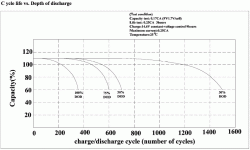Elmweaver
10 W
I gathered the informtion below from alot of different places on the internet and have put them together in a way I hope will be informative for the user at large. It should be noted that the cycle lifes stated are for general purpose batteries which are the ones commonly used because of low cost.
Some batteries like the B&B Batteries EB Series of batteries are made for high cycle life with deep discharge and will provide more cycles then standard batteries when used for electric transportation needs. The voltages listed below are still valid for all SLA batteries.
This Information is for Sealed Lead Acid (SLA) Batteries Only:
12 Volt batteries have 6 cells each
24 Volts = 12 cells
36 Volts = 18 cells
48 Volts = 24 cells
Fully charged cell voltage = 2.1 Volts
Nominal cell voltage = 2.0 Volts
The recommended end-of-discharge voltage for sealed lead-acid is 1.75 Volts per cell. The discharge does not follow the preferred flat curve of nickel and lithium-based chemistries. Instead, Lead-acid has a gradual voltage drop with a rapid drop towards the end of discharge.
The sealed lead-acid battery should not be discharged beyond 1.75 Volts per cell, nor should it be stored in a discharged state. The cells of a discharged lead-acid sulfate, a condition that renders the battery useless if left in that state for a few days. Always keep the open terminal voltage at 2.10 Volts and higher.
The cycle life of sealed lead-acid is directly related to the depth of discharge. The typical number of discharge/charge cycles at 25°C (77°F) with respect to the depth of discharge is:
* 50 - 100 cycles with 100% depth of discharge (full discharge)
* 150 - 250 cycles with 70% depth of discharge (deep discharge)
* 300 - 500 cycles with 50% depth of discharge (partial discharge)
* 800 and more cycles with 30% depth of discharge (shallow discharge)
Cycle life measured until 80% of original capacity can no longer be recovered by charging.
Some batteries like the B&B Batteries EB Series of batteries are made for high cycle life with deep discharge and will provide more cycles then standard batteries when used for electric transportation needs. The voltages listed below are still valid for all SLA batteries.
This Information is for Sealed Lead Acid (SLA) Batteries Only:
12 Volt batteries have 6 cells each
24 Volts = 12 cells
36 Volts = 18 cells
48 Volts = 24 cells
Fully charged cell voltage = 2.1 Volts
Nominal cell voltage = 2.0 Volts
The recommended end-of-discharge voltage for sealed lead-acid is 1.75 Volts per cell. The discharge does not follow the preferred flat curve of nickel and lithium-based chemistries. Instead, Lead-acid has a gradual voltage drop with a rapid drop towards the end of discharge.
The sealed lead-acid battery should not be discharged beyond 1.75 Volts per cell, nor should it be stored in a discharged state. The cells of a discharged lead-acid sulfate, a condition that renders the battery useless if left in that state for a few days. Always keep the open terminal voltage at 2.10 Volts and higher.
The cycle life of sealed lead-acid is directly related to the depth of discharge. The typical number of discharge/charge cycles at 25°C (77°F) with respect to the depth of discharge is:
* 50 - 100 cycles with 100% depth of discharge (full discharge)
* 150 - 250 cycles with 70% depth of discharge (deep discharge)
* 300 - 500 cycles with 50% depth of discharge (partial discharge)
* 800 and more cycles with 30% depth of discharge (shallow discharge)
Cycle life measured until 80% of original capacity can no longer be recovered by charging.






